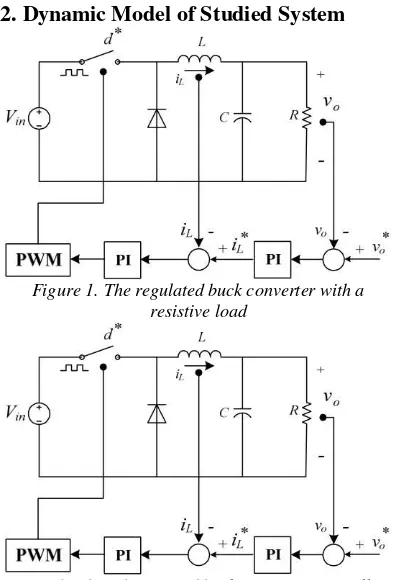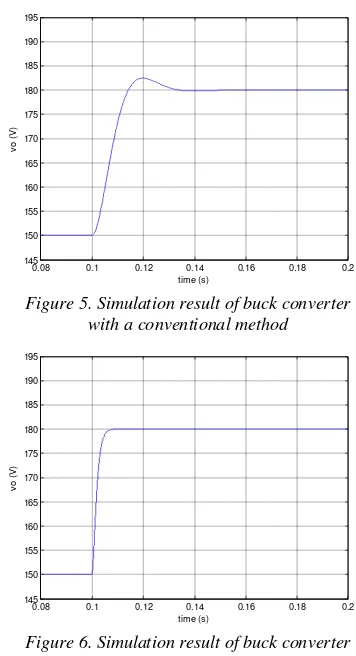Self Tuning of Cascade PI Controller for Buck Converter
Based on Adaptive Interaction
Sabat Anwari
Electrotechnic Departmen of ITENAS Bandung sabat.anwari @gmail.com
Abstract
DC–DC converter convert DC voltage signal from high level to low level signal or it can be vise versa depending on the type of converter used in system. Buck converter is one of the most important components of circuit, it converts voltage signal from high DC signal to low voltage. In buck converter, a high speed switching devices are placed and the better efficiency of power conversion with the steady state can be achieved. Its nonlinearities and uncertainties have increased the complexity of associated controllers so desired performance is achieved. However, cascade-PI controllers are still used to address this problem due to its relative implementation easiness, negating the complexity to the tuning strategy. The relative simplicity of system-specific PI control tuning methods enable a desired system response characteristic: robust, rapid error attenuation with minimal overshoot, zero steady-state off-set, to be easily attained. In this paper, an adaptive interaction is adopted to tune PI controller. The method is simple and effective way to perform gradient descent in the parameter space. The tuning algorithm requires no knowledge of the plant to be controlled. This makes the algorithm robust to changes in the plant.
Keywords : buck converter, cascade, PI controller, self tuning, adaptive interaction.
1. Introduction
DC-DC converters with computerized digital control methods picked up ubiquity because of their high productivity, low power utilization, higher resistance to natural changes, for example, temperature and maturing of parts, capacity to interface effortlessly, of programmability and to actualize advanced control plans. Their requisitions incorporate compact electronic gadgets, for example, computer and smart phones others (Mondal, 2014).
A buck converter is a time varying system as its dynamical behavior depends on a switch controlled through PWM; moreover, the relation between the PWM duty cycle and the output voltage is nonlinear (Ibarra, et.al., 2015).
Besides DC/DC converters have been successfully controlled in the past, it was until 90s when its nonlinear characteristics where formally discussed and some advanced control techniques were used to improve their performance. The control objectives have been met before the system was thoroughly understood as stated in (Tse and Bernardo, 2002). However, the convenience of modeling
them in a simplified manner has made
researchers also to follow this path despite of the need of two different models dependent on current conditions: continuous and discontinuous
conduction modes (CCM and DCM). One of the most used methods to achieve linear representation of voltage converters is the Small-signal state-space averaging (Tse and Bernardo, 2002).
Although simpler linear models allow the designer to consider well-known frequency-domain constraints and design techniques, its validity is restricted to a determined bandwidth and can not attain nonlinear behavior; as the linear model is desired to be kept simple, the control loop complexity must be increased through a more dependable controller (Gupta, et.al., 1997). This has lead to an increasing number of works related to control implementation under parametric variations, uncertain environments, and ambiguous measurements which commonly adopts one single control technique and a determined set of
tests to validate converter’s performance.
mode control is that the inner loop changes the inductor into a voltage-dependent current source at frequencies lower than crossover frequency of the current loop.
A commonly used way to implement a current mode control is using two Proportional Integral (PI) controllers; one for the inner current loop and one more for the outer voltage one. Furthermore, to improve the robustness, an on-line self tuning PI controller by using adaptive interaction, is proposed. An adaptive interaction technique is used to tune the parameters of PI controller. Our approach is based on a recently developed theory of adaptive interaction (Lin, et. al., 2000). Using this theory, the controlled system is decomposed into three subsystems consisting the plant, the proportional, and the integral. The parameters of PI controller, 𝐾𝑝 and 𝐾𝑖 are viewed as the interactions between these
three subsystems. A general adaptation algorithm developed in the theory of adaptive interaction is applied to self-tuning these coefficients. The algorithm is simple and effective.
2. Dynamic Model of Studied System
Figure 1. The regulated buck converter with a resistive load
Figure 2. The schematic of buck converter controllers
The buck converter considered in this paper is shown in Fig. 1. It consists of a DC voltage source 𝑉𝑖𝑛, the elements of buck converter represented by 𝐿 and 𝐶, the resistive load 𝑅, and the PI controllers of current loop (inner loop) and voltage loop (outer loop) represented by 𝐾𝑝𝑣, 𝐾𝑖𝑣, 𝐾𝑝𝑖, and 𝐾𝑖𝑖, respectively.
The schematic of cascade PI controllers for a buck converter is depicted in Fig. 2 (adopted from Chonsatidjamroen, et. al., 2012).
The dynamic model of a controlled buck converter as shown in Fig. 1 derived from the generalized state-space averaging (GSSA) modeling method can be written as:
𝒙 =𝑨𝒙+𝑩
𝒚=𝑪𝒙+𝑫𝒖 (1)
where state-variable 𝒙= 𝑖𝐿 𝑣𝑜 𝑥𝑣 𝑥𝑖 𝑇, input 𝒖= 𝑣𝑜∗, and output 𝒚= 𝑣𝑜 .
The details of 𝑨,𝑩,𝑪,𝑫are as follows:
𝑨=
−𝐾𝑝𝑖𝐿𝑉𝑖𝑛 −
𝐾𝑝𝑣𝐾𝑝𝑖𝑉𝑖𝑛+1
𝐿
𝐾𝑖𝑣𝐾𝑝𝑖𝑉𝑖𝑛 𝐿
𝐾𝑖𝑖𝑉𝑖𝑛 𝐿
1
𝐶 −
1
𝑅𝐶 0 0
0 −1
−1 −𝐾𝑝𝑣
0 𝐾𝑖𝑣
0 0
,
𝑩=
𝐾𝑝𝑣𝐾𝑝𝑖𝑉𝑖𝑛 𝐿
0 1 𝐾𝑝𝑣
,𝑪= 0 1 0 0 ,𝑫= 0
(2)
Figure 3. Response of 𝑣𝑜for changing the 𝑣𝑜∗from 150 V to 180 V
(Chonsatidjamroen, et. al., 2012)
The set of parameters for the system in Fig.1 is given as follows: 𝑅= 120 Ω, 𝑅= 15 mH (∆𝐼= 0.1 A), 𝐶= 150 𝜇F (∆𝑉= 10 mV), 𝑉𝑖𝑛 = 200 V, and 𝑇𝑠= 0.1 ms. Fig. 3 shows the
respectively. The details how to design the PI controllers using the classical method for buck converter having the schematic as depicted in Fig. 2 can be found in (Tsang and Chan, 2005).
3. Theory of Adaptive Interaction
The theory of adaptive interaction considers a complex system consisting of 𝒩 subsystems which we called devices. Each device (indexed by 𝑛 ∈ 𝒩 ≔ 1, 2,⋯,𝒩 ) has an integrable output signal 𝑦𝑛 and an integrable input signal 𝑥𝑛. The dynamics of each device is described by
a causal functional
where ∘ denote composition.
Figure 4. A typical decomposition of a system for adaptive interaction
We assume the Frechet derivative of ℱn exixts. We further assume that each device is a single input single output system.
An interaction between two devices consists of a functional dependence of the input of one of the devices on the outputs of the others and is mediated by an information carrying connections denoted by 𝑐. The set of all connections is denoted by 𝐶.
We assume that there is at most one connection from one device to another. Let 𝑝𝑟𝑒𝑐 be the device whose output is conveyed by connection 𝑐 and 𝑝𝑜𝑠𝑡𝑐 the device whose input depends on the signal conveyed by connection 𝑐. We denote the set of input interactions for the 𝑛th device by 𝐼𝑛= 𝑐 ∶ 𝑝𝑟𝑒𝑐 =𝑛 and the set of output
interactions by 𝑂𝑛 = 𝑐 ∶ 𝑝𝑜𝑠𝑡𝑐=𝑛 . A typical system is illustrated in Figure 4. In the figure, for example, the set of input interactions of Device 2 is 𝐼2= 𝑐1,𝑐3 and the set of output interactions output of other devices via connections in 𝐼𝑛 and possibly an external input signal 𝑢𝑛(𝑡):
To simplify the notation, in the rest of the paper, we will eliminate when appropriate the explicit reference to time 𝑡.
The goal of our adaptation algorithm is to adapt the connection weights 𝛼𝑐 so that some performance index 𝐸 𝑦1,⋯ 𝑦𝑛,𝑢1,⋯ 𝑢𝑛 as a function of the external inputs and outputs will be minimized. The algorithm is given in the following theorem (Lin, et. al., 2000):
Theorem 1: For the system with dynamics given
by
where 𝛾> 0 is some adaptation coefficient.
4. Controller Designs
In this section, the controller designs for the buck converter via the classical and adaptive interaction methods are illustrated.
4.1 Classical Method
The details of PI controller design using the classical method can be found in (Tsang and Chan, 2005). The PI parameters for the classical method in this paper are designed by selecting 𝜉𝑣= 0.8, 𝜉𝑖 = 0.8, 𝜔𝑛𝑖 = 20 × 120 rad/s, and
𝜔𝑛𝑣 = 120 rad/s. Hence, the PI controller
connections, 𝑂𝑝𝑜𝑠𝑡𝑐 =𝑂3= 0, the adaptation algorithm of the previous section reduces to
𝛼 𝑐=−𝛾𝜕𝑦𝜕𝐸
𝑝𝑜𝑠𝑡 𝑐∘
ℱ𝑝𝑜𝑠𝑡′ 𝑐 𝑥𝑝𝑜𝑠𝑡𝑐 ∘ 𝑦𝑝𝑜𝑠𝑡𝑐
(12)
We take our goal as to minimize the error
𝐸=𝑒2 (13) the Frechet derivative, and the output of device.
To calculate the Frechet derivative, let us consider the functional of the following form
ℱ 𝑥 = 𝑓0𝑡 (𝑥 𝜏 ,𝜏)𝑑𝜏 (16) It can be shown (Luenberger, 1968, page 175) that the Frechet differential of ℱ is equal to its Gateaux differential which is given by
𝛿ℱ 𝑥; = 𝑓0𝑡 𝑥(𝑥 𝜏 ,𝜏)𝑑𝜏 (17) function ℱ is given by the convolution
ℱ 𝑥 = 𝑥 𝜏 𝑔 𝑡 − 𝜏 𝑑𝜏0𝑡 (19) where 𝑔(𝑡) is the impulse response. Therefore the Frechet derivative
ℱ′ 𝑥 ∘ = 𝑔 𝑡 − 𝜏 𝜏 𝑑𝜏𝑡
0 (20)
For many practical systems, as shown in (Lin, et. al., 2000) the Frechet derivative can be approximated by
ℱ′ 𝑥 ∘ =𝛽 (21) where 𝛽 is some constant.
Substitute the above approximation into the Frechet tuning algorithm, adopted from (Lin, et. al., 2000), self tuning algorithm is as follows
𝐾 𝑝𝑣 =−𝛾𝑒𝑣𝑒𝑣 (22) described above, digital simulation was carried out on a buck converter, as shown in Figure 1 having the controllers designed by using the classical method and the Selft Tuning Proportional Integral (STPI) controller. The control simulation results are shown in Figure 5 and Figure 6.
Figure 5. Simulation result of buck converter with a conventional method
Figure 6. Simulation result of buck converter with a STPI controller converter using Selft Tuning Proportional Integral (STPI) controller. Applying a classical method to the system, the transient response achieved is slightly lower than the STPI. There is no overshoot when STPI is applied while using classical method there is a little overshoot. Results in Fig. 5 and Figure 6 shows that the STPI performs slightly better than the classical method.
6. Conclusions
References
Chonsatidjamroen, S., Areerak, K. N., Areerak, K. L., and Srikaew, A. (2012) Optimized cascade PI controllers of buck converters using particle swarm optimization algorithm. In The 11th WSEAS International Conference on Artificial Intelligence, Knowledge Engineering and Data Bases (AIKED'12). p. 21-26. Cambridge. United Kingdom, February 22-24.
Dixon, L. (1985) Current-mode control of Switching power supplies. in Unitrode, SM400: p. 1–9. United States.
Gupta, T., Boudreaux, R., Nelms, R., and Hung, J. (1997) Implementation of a fuzzy controller for DC-DC converters using an inexpensive 8-b microcontroller. in IEEE Transactions on Industrial Electronics, 44 (5). p. 661–669. Oct.. Ibarra, L., Macias, I., Ponce, P., and Molina, A.
(2015). On DC/DC voltage buck converter control improvement through the QFT approach. In New Developments in Circuits, Systems, Signal Processing, Communication and Computers. p. 183-190.
Lin, F., Brand, R. D., and Saikalis, G. (2000) Self tuning of PID controllers by adaptive interaction. in Proceedings of the American Control Conference. Chicago. Illinois, June.
Luenberger, D. G. (1968) Optimization by Vector Space Methods. John Wiley & Sons,.
Mondal, A. (2014) Digital PID controller design for DC-DC buck converter. Master Thesis. National Institute of Technology. Rourkela. India. Tsang, K. M. and Chan, W. L. (2005) Cascade

